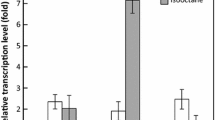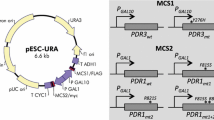Abstract
Organic solvents are toxic to living cells. In eukaryotes, cells with organic solvent tolerance have only been found in Saccharomyces cerevisiae. Although several factors contributing to organic solvent tolerance have been identified in previous studies, the mechanism of how yeast cells naturally respond to organic solvent stress is not known. We demonstrated that the pleiotropic drug resistance (PDR) pathway contributed to response to organic solvent stress. Activation of the PDR pathway by mutations in the transcription factors Pdr1p and Pdr3p led to organic solvent tolerance. Exposure to organic solvents also induced transcription levels of PDR5, which encodes a major drug efflux pump. Overproduction of Pdr5p improved organic solvent tolerance, presumably by exporting organic solvents out of the cell. In addition, we showed that the cell wall integrity (CWI) pathway was induced in response to organic solvents to upregulate genes encoding the cell wall-related proteins Wsc3p and Ynl190wp. WSC3 and YNL190W were upregulated independently of the PDR pathway. Among the components of the CWI pathway, the cell surface sensors (Wsc3p and Mid2p) and the transcription factors (Swi4p and Swi6p) appeared to be particularly involved in the response to organic solvents. Our findings indicate that S. cerevisiae activates two different signaling pathways, the PDR pathway and the CWI pathway, to cope with stresses from organic solvents.





Similar content being viewed by others
References
Balzi E, Wang M, Leterme S, Van Dyck L, Goffeau A (1994) PDR5, a novel yeast multidrug resistance conferring transporter controlled by the transcription regulator PDR1. J Biol Chem 269:2206–2214
Carvajal E, van den Hazel HB, Cybularz-Kolaczkowska A, Balzi E, Goffeau A (1997) Molecular and phenotypic characterization of yeast PDR1 mutants that show hyperactive transcription of various ABC multidrug transporter genes. Mol Gen Genet 256:406–415
Decottignies A, Lambert L, Catty P, Degand H, Epping EA, Moye-Rowley WS, Balzi E, Goffeau A (1995) Identification and characterization of SNQ2, a new multidrug ATP binding cassette transporter of the yeast plasma membrane. J Biol Chem 270:18150–18157
Decottignies A, Grant AM, Nichols JW, de Wet H, McIntosh DB, Goffeau A (1998) ATPase and multidrug transport activities of the overexpressed yeast ABC protein Yor1p. J Biol Chem 273:12612–12622
Delahodde A, Delaveau T, Jacq C (1995) Positive autoregulation of the yeast transcription factor Pdr3p, which is involved in control of drug resistance. Mol Cell Biol 15:4043–4051
Delaveau T, Delahodde A, Carvajal E, Subik J, Jacq C (1994) PDR3, a new yeast regulatory gene, is homologous to PDR1 and controls the multidrug resistance phenomenon. Mol Gen Genet 244:501–511
DeRisi J, van den Hazel B, Marc P, Balzi E, Brown P, Jacq C, Goffeau A (2000) Genome microarray analysis of transcriptional activation in multidrug resistance yeast mutants. FEBS Lett 470:156–160
Devaux F, Carvajal E, Moye-Rowley S, Jacq C (2002) Genome-wide studies on the nuclear PDR3-controlled response to mitochondrial dysfunction in yeast. FEBS Lett 515:25–28
Fukumaki T, Inoue A, Moriya K, Horikoshi K (1994) Isolation of a marine yeast that degrades hydrocarbon in the presence of organic solvent. Biosci Biotech Biochem 58:1784–1788
Gao C, Wang L, Milgrom E, Shen WC (2004) On the mechanism of constitutive Pdr1 activator-mediated PDR5 transcription in Saccharomyces cerevisiae: evidence for enhanced recruitment of coactivators and altered nucleosome structures. J Biol Chem 279:42677–42686
Gray JV, Ogas JP, Kamada Y, Stone M, Levin DE, Herskowitz I (1997) A role for the Pkc1 MAP kinase pathway of Saccharomyces cerevisiae in bud emergence and identification of a putative upstream regulator. EMBO J 16:4924–4937
Hallstrom TC, Moye-Rowley WS (2000) Multiple signals from dysfunctional mitochondria activate the pleiotropic drug resistance pathway in Saccharomyces cerevisiae. J Biol Chem 275:37347–37356
Inoue A, Horikoshi K (1989) A Pseudomonas thrives in high concentrations of toluene. Nature 338:264–266
Jendretzki A, Wittland J, Wilk S, Straede A, Heinisch JJ (2011) How do I begin? Sensing extracellular stress to maintain yeast cell wall integrity. Eur J Cell Biol 90:740–744
Jungwirth H, Kuchler K (2006) Yeast ABC transporters—a tale of sex, stress, drugs and aging. FEBS Lett 580:1131–1138
Kanda T, Miyata N, Fukui T, Kawamoto T, Tanaka A (1998) Doubly entrapped baker’s yeast survives during the long-term stereoselective reduction of ethyl 3-oxobutanoate in an organic solvent. Appl Microbiol Biotechnol 49:377–381
Katzmann DJ, Burnett PE, Golin J, Mahe Y, Moye-Rowley WS (1994) Transcriptional control of the yeast PDR5 gene by the PDR3 gene product. Mol Cell Biol 14:4653–4661
Katzmann DJ, Hallstrom TC, Mahe Y, Moye-Rowley WS (1996) Multiple Pdr1p/Pdr3p binding sites are essential for normal expression of the ATP binding cassette transporter protein-encoding gene PDR5. J Biol Chem 271:23049–23054
Kawamoto T, Kanda T, Tanaka A (2001) Preparation of an organic solvent-tolerant strain from baker’s yeast. Appl Microbiol Biotechnol 55:476–479
Kolaczkowski M, Kolaczowska A, Luczynski J, Witek S, Goffeau A (1998) In vivo characterization of the drug resistance profile of the major ABC transporters and other components of the yeast pleiotropic drug resistance network. Microb Drug Resist 4:143–158
Kuroda K, Matsui K, Higuchi S, Kotaka A, Sahara H, Hata Y, Ueda M (2009) Enhancement of display efficiency in yeast display system by vector engineering and gene disruption. Appl Microbiol Biotechnol 82:713–719
Levin DE (2011) Regulation of cell wall biogenesis in Saccharomyces cerevisiae: the cell wall integrity signaling pathway. Genetics 189:1145–1175
MacPherson S, Larochelle M, Turcotte B (2006) A fungal family of transcriptional regulators: the zinc cluster proteins. Microbiol Mol Biol Rev 70:583–604
Mamnun YM, Pandjaitan R, Mahe Y, Delahodde A, Kuchler K (2002) The yeast zinc finger regulators Pdr1p and Pdr3p control pleiotropic drug resistance (PDR) as homo- and heterodimers in vivo. Mol Microbiol 46:1429–1440
Matsui K, Hirayama T, Kuroda K, Shirahige K, Ashikari T, Ueda M (2006) Screening for candidate genes involved in tolerance to organic solvents in yeast. Appl Microbiol Biotechnol 71:75–79
Matsui K, Teranishi S, Kamon S, Kuroda K, Ueda M (2008) Discovery of a modified transcription factor endowing yeasts with organic-solvent tolerance and reconstruction of an organic-solvent-tolerant Saccharomyces cerevisiae strain. Appl Environ Microbiol 74:4222–4225
Meyers S, Schauer W, Balzi E, Wagner M, Goffeau A, Golin J (1992) Interaction of the yeast pleiotropic drug resistance genes PDR1 and PDR5. Curr Genet 21:431–436
Miura N, Kirino A, Endo S, Morisaka H, Kuroda K, Takagi M, Ueda M (2012) Tracing putative trafficking of the glycolytic enzyme enolase via SNARE-driven unconventional secretion. Eukaryot Cell 11:1075–1082
Monk BC, Goffeau A (2008) Outwitting multidrug resistance to antifungals. Science 321:367–369
Moye-Rowley WS (2003) Transcriptional control of multidrug resistance in the yeast Saccharomyces. Prog Nucleic Acid Res Mol Biol 73:251–279
Nishida N, Ozato N, Matsui K, Kuroda K, Ueda M (2013) ABC transporters and cell wall proteins involved in organic solvent tolerance in Saccharomyces cerevisiae. J Biotechnol 165:145–152
Nourani A, Papajova D, Delahodde A, Jacq C, Subik J (1997) Clustered amino acid substitutions in the yeast transcription regulator Pdr3p increase pleiotropic drug resistance and identify a new central regulatory domain. Mol Gen Genet 256:397–405
Rajavel M, Philip B, Buehrer BM, Errede B, Levin DE (1999) Mid2 is a putative sensor for cell integrity signaling in Saccharomyces cerevisiae. Mol Cell Biol 19:3969–3976
Sardessai YN, Bhosle S (2004) Industrial potential of organic solvent tolerant bacteria. Biotechnol Prog 20:655–660
Sauna ZE, Bohn SS, Rutledge R, Dougherty MP, Cronin S, May L, Xia D, Ambudkar SV, Golin J (2008) Mutations define cross-talk between the N-terminal nucleotide-binding domain and transmembrane helix-2 of the yeast multidrug transporter Pdr5: possible conservation of a signaling interface for coupling ATP hydrolysis to drug transport. J Biol Chem 283:35010–35022
Segura A, Molina L, Fillet S, Krell T, Bernal P, Munoz-Rojas J, Ramos JL (2012) Solvent tolerance in Gram-negative bacteria. Curr Opin Biotechnol 23:415–421
Servos J, Haase E, Brendel M (1993) Gene SNQ2 of Saccharomyces cerevisiae, which confers resistance to 4-nitroquinoline-N-oxide and other chemicals, encodes a 169 kDa protein homologous to ATP-dependent permeases. Mol Gen Genet 236:214–218
Shahi P, Gulshan K, Moye-Rowley WS (2007) Negative transcriptional regulation of multidrug resistance gene expression by an Hsp70 protein. J Biol Chem 282:26822–26831
Sikkema J, de Bont JA, Poolman B (1995) Mechanisms of membrane toxicity of hydrocarbons. Microbiol Rev 59:201–222
Sikorski RS, Hieter P (1989) A system of shuttle vectors and yeast host strains designed for efficient manipulation of DNA in Saccharomyces cerevisiae. Genetics 122:19–27
Simonics T, Kozovska Z, Michalkova-Papajova D, Delahodde A, Jacq C, Subik J (2000) Isolation and molecular characterization of the carboxy-terminal pdr3 mutants in Saccharomyces cerevisiae. Curr Genet 38:248–255
Straede A, Corran A, Bundy J, Heinisch JJ (2007) The effect of tea tree oil and antifungal agents on a reporter for yeast cell integrity signalling. Yeast 24:321–334
Thakur JK, Arthanari H, Yang F, Pan SJ, Fan X, Breger J, Frueh DP, Gulshan K, Li DK, Mylonakis E, Struhl K, Moye-Rowley WS, Cormack BP, Wagner G, Naar AM (2008) A nuclear receptor-like pathway regulating multidrug resistance in fungi. Nature 452:604–609
Torres S, Pandey A, Castro GR (2011) Organic solvent adaptation of Gram positive bacteria: applications and biotechnological potentials. Biotechnol Adv 29:442–452
Verna J, Lodder A, Lee K, Vagts A, Ballester R (1997) A family of genes required for maintenance of cell wall integrity and for the stress response in Saccharomyces cerevisiae. Proc Natl Acad Sci USA 94:13804–13809
Wilk S, Wittland J, Thywissen A, Schmitz HP, Heinisch JJ (2010) A block of endocytosis of the yeast cell wall integrity sensors Wsc1 and Wsc2 results in reduced fitness in vivo. Mol Genet Genom 284:217–229
Wolfger H, Mahe Y, Parle-McDermott A, Delahodde A, Kuchler K (1997) The yeast ATP binding cassette (ABC) protein genes PDR10 and PDR15 are novel targets for the Pdr1 and Pdr3 transcriptional regulators. FEBS Lett 418:269–274
Zu T, Verna J, Ballester R (2001) Mutations in WSC genes for putative stress receptors result in sensitivity to multiple stress conditions and impairment of Rlm1-dependent gene expression in Saccharomyces cerevisiae. Mol Genet Genom 266:142–155
Acknowledgments
This work was supported by a Grant-in-Aid for Scientific Research (C) (No. 25450099) and a Grant-in-Aid for JSPS Fellows (No. 243819) from the Japan Society for the Promotion of Science, and the commission for Development of Artificial Genes Synthesis Technology for Creating Innovative Biomaterial from the Ministry of Economy, Trade and Industry (METI), Japan.
Author information
Authors and Affiliations
Corresponding author
Additional information
Communicated by Stefan Hohmann.
Electronic supplementary material
Below is the link to the electronic supplementary material.
Rights and permissions
About this article
Cite this article
Nishida, N., Jing, D., Kuroda, K. et al. Activation of signaling pathways related to cell wall integrity and multidrug resistance by organic solvent in Saccharomyces cerevisiae . Curr Genet 60, 149–162 (2014). https://doi.org/10.1007/s00294-013-0419-5
Received:
Revised:
Accepted:
Published:
Issue Date:
DOI: https://doi.org/10.1007/s00294-013-0419-5




